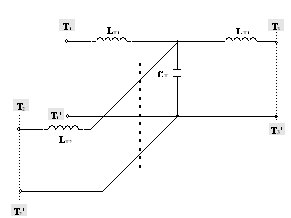 |
|
||
|
MODELS AND PARAMETERS There are two kinds of models used for evaluation of trace segments and discontinuities: lumped models and distributed (transmission line) models. In figure 2 the first one is presented. The lumped model of the T-branch is based on R,L,C parameters and it looks as a 3D-low pass filter. Due to the very low value, even for high frequencies, the resistances of the arms can be neglected without worries. The transmission line model uses line segments of Z0 characteristic impedance, tpd propagation delay (both in accordance with interconnection structure geometry and electrical parameters) and segment length. But because for this type of discontinuity the propagation delay is much smaller than any usual rise time the distributed model it is not necessary to be used, the simulation of the lumped model offering both a good approximation of the T-branch behavior and an enough fast and simply evaluation.
Fig. 2 Lumped model of T-branch
|
 Schematic design of PCB projects
Schematic design of PCB projects 
